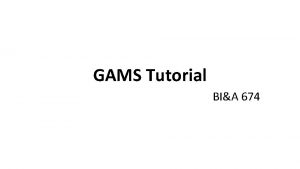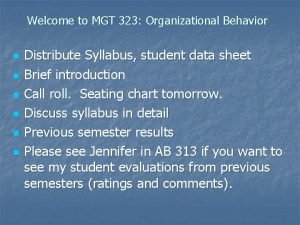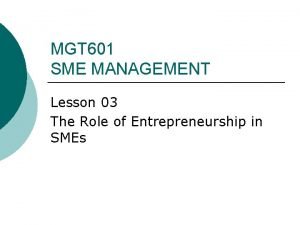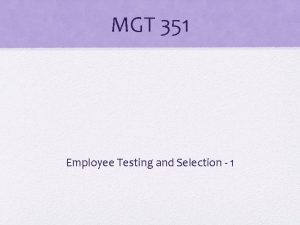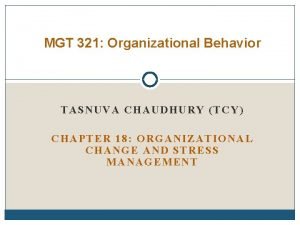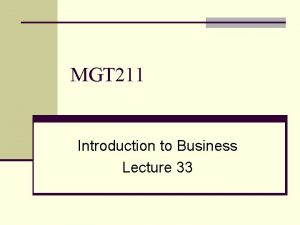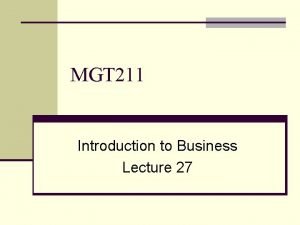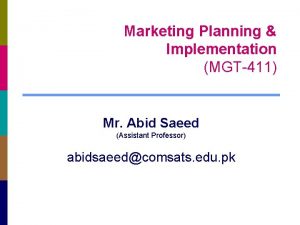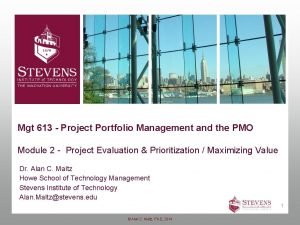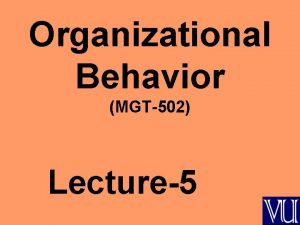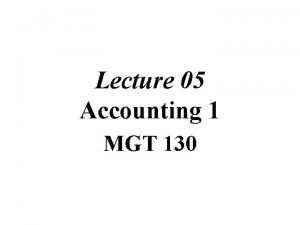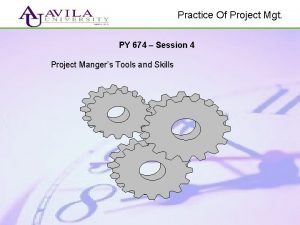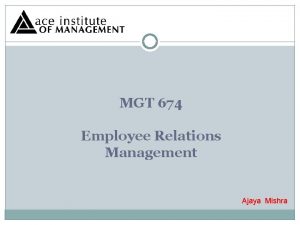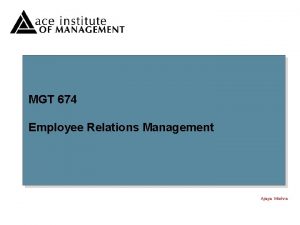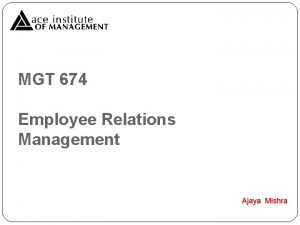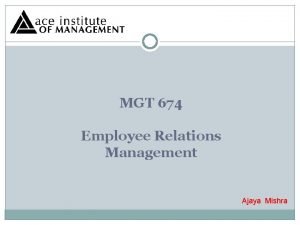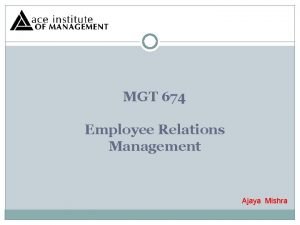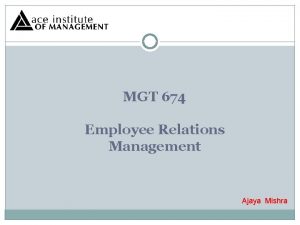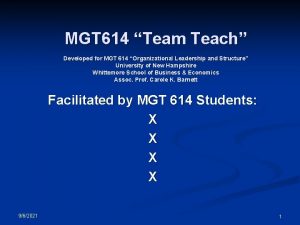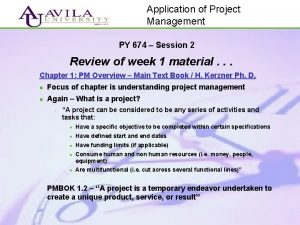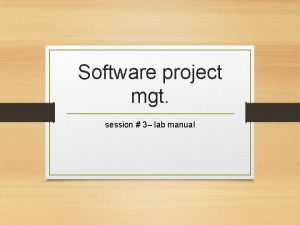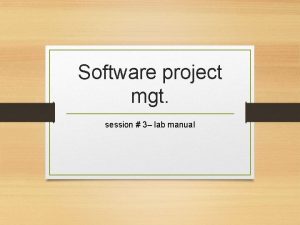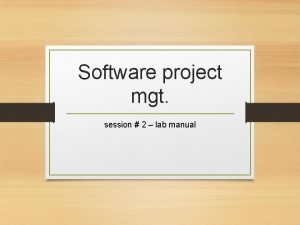Practice Of Project Mgt PY 674 Session 3

















- Slides: 17

Practice Of Project Mgt. PY 674 – Session 3 Project Manger’s Tools and Skills Copyright © The Conestoga Group 2003 1

Application of Project Management PY 674 – Session 3 Review of week 2 material. . . Chapter 19: Contracts and Procurement n Generally within the US business process the following 5 major cycles are conducted: Ø The Requirements cycle: Definition of project boundaries Ø The Requisition cycle: Analysis of Sources Ø The Solicitation cycle: The bidding process Ø The Award cycle: Select Contractor / Vendor & award work Ø The Contract Admin cycle: Managing the subcontractor until completion of the contract. PMBOK Chapter 12 Copyright © The Conestoga Group 2003 2

Application of Project Management PY 674 – Session 3 Review of week 2 material. . . 19. 6: Types of Contracts n Generally there are 5 types of contracts within the US business process: Ø Ø Ø Fixed Price (FP) Cost-Plus fixed fee (CPFF) or percentage fee (CPPF) Guaranteed Max- shared savings (GMSS) Fixed-Price incentive fee (FPIF) Cost-Plus incentive fee (CPIF) PMBOK Chapter 12 Copyright © The Conestoga Group 2003 3

Application of Project Management PY 674 – Session 3 Chapter 10: Working with Executives n The project sponsor, (i. e. – the executive), usually comes from the executive “levels” and has the primary responsibility of maintaining executive–client contact. n The sponsor can also provides guidance on: Ø Objective setting Ø Priority setting Ø Project organization structure Ø Project policies and procedures Ø Project master planning Ø Up-front planning Ø Key staffing Ø Monitoring execution Ø Conflict resolution PMBOK Chapter 2 Copyright © The Conestoga Group 2003 4

Application of Project Management PY 674 – Session 3 Chapter 10: Working with Executives n The project sponsor takes on different dimensions (i. e. – roles) based on the life cycle project phase the project is in. n Project sponsors MUST maintain open-door policies (but the executive will manage these to fit schedules and styles) don’t take access personally. n Executives in large diversified corporations are extremely busy with strategic planning activities and simply do not have the time to properly function as a sponsor. In such cases, sponsorship will fall one level below senior management. n Not all projects require a high level executive to act as a project sponsor n Review Table 10 -2 on page 374. . . PMBOK Chapter 2 Copyright © The Conestoga Group 2003 5

Application of Project Management PY 674 – Session 3 Chapter 10: Working with Executives n n n Q. How does a PM handle a micro managing project sponsor? Q. What is a project “stop light” report? Managing “scope creep” – PM’s MUST monitor projects for scope creep and develop plans for controlling scope changes. PMBOK Chapter 5 Copyright © The Conestoga Group 2003 6

Application of Project Management PY 674 – Session 3 Chapter 10: Working with Executives n The Executive Champion – the EC “drives” the implementation of project management down into the organization and accelerates its acceptance because. . . - n n Their involvement IMPLIES executive-level support and interest! Conflicts can occur even at the executive level. One party demands that the project be cancelled (for whatever reason) while another supports it and requires that it continue without delay. The PM should stay out of that discussion unless asked for their input. PMBOK Chapter 5 Copyright © The Conestoga Group 2003 7

Application of Project Mgt. PY 674 – Session 3 1. Estimate at completion (EAC) is a periodic evaluation of: A. Cost of work completed B. Value of work performed C. Anticipated total cost at project completion D. What it will cost to finish the job n Answer – C, When you look at earned value, many of the terms have similar definitions. This could get you into trouble. Since the EAC means the estimate at completion, choice C must be the best answer. Choice D is the definition of ETC, estimate to complete. Copyright © The Conestoga Group 2003 8

Application of Project Mgt. PY 674 – Session 3 2. Rearranging resources so that a constant number of resources are used each month is called: A. Crashing B. Floating C. Leveling D. Fast tracking n Answer – C, The key to this question is the phrase “constant number used each month. ” Only leveling, choice C, has such an effect on the schedule. Copyright © The Conestoga Group 2003 9

Application of Project Mgt. PY 674 – Session 3 3. Double declining balance is a form of: A. Decelerated depreciation B. Straight line depreciation C. Accelerated depreciation D. Life cycle costing n Answer – C, we need to know that double declining balance is a form of depreciation. That eliminates choice D. We also know that double declining balance is a form of accelerated depreciation. Therefore C is the best choice. Copyright © The Conestoga Group 2003 10

Application of Project Mgt. PY 674 – Session 3 4. Which of the following is not needed in order to come up with a project estimate? A. WBS B. Network diagram C. Risks D. Change control procedures n Answer – D, A change control procedure is not required to obtain estimates, but without the other three, you cannot develop the estimates. You need the WBS to define the tasks, the network diagram to see the dependencies and the risks to determine contingency. Copyright © The Conestoga Group 2003 11

Application of Project Mgt. PY 674 – Session 3 5. Which of the following is an example of a parametric estimate? A. Dollars per module B. Learning bend C. Bottom-up D. CPM n Answer – A, Parametric estimates use mathematical model to predict project cost or time. Copyright © The Conestoga Group 2003 12

Application of Project Mgt. PY 674 – Session 3 6. A customer has given you a scope of work for a complex, eight-month project that has a few unknowns. The customer has asked you to just “get it done” and only wants to see you at the end of eight months when you deliver the finished project. Under these circumstances, which of the following is the BEST thing to do? A. Complete the project as requested, but verify its scope with the customer occasionally throughout the project B. Complete the project within eight months without contacting the customer during this time C. Ask management to check in with the customer occasionally D. Complete the project, but document that the customer did not want contact n Answer – A, It is unethical to ignore scope verification, as it will ad risk that the project will not meet the customer’s needs. Therefore choice A is the best answer. If this is a real world situation, one would probably work with the customer to effectively handle © verification so as. Group to cause as little Copyright The Conestoga 2003 13

Application of Project Mgt. PY 674 – Session 3 7. During project execution, a project team delivers a project deliverable to the customer. However, the customer neither acknowledges the deliverable nor replies to the project manager’s request for verification. What is the BEST thing to do? A. Continue with the project B. Document the situation C. Contact management for help D. Call a meeting of the team n Answer – C, In this case, you need to bring in bigger guns. Without scope verification at the end of the project phase, you may well be creating the “wrong thing. ” This is where management can protect the project. Copyright © The Conestoga Group 2003 14

Application of Project Mgt. PY 674 – Session 3 8. Which of the following BEST describes the relationship between standard deviation and risk? n - A. Nothing - B. SD tells you if the estimate is accurate - C. SD tells you how unsure the estimate is - D. SD tells you if the estimate includes a pad Answer – C, Choice D can’t be the best answer since there is no such thing as a pad in project management. An estimate might be inflated but it is because of risks, not padding. An estimate can have a wide range (choice B) and still be accurate if the item estimated includes risks. Choice A is not best, as the standard deviation tells you the amount of uncertainty or risk involved in the estimate for the work package or task. Copyright © The Conestoga Group 2003 15

Application of Project Mgt. PY 674 – Session 3 9. A project has three critical paths. Which of the following BEST describes how this affects the project? A. It makes it easier to manage B. It increases project risk C. It requires more people D. It makes it more expensive n Answer – B, Though having three critical paths COULD later cost more (choice D) or require more people (choice C) the best answer, or the answer that is always definitely true, is B. Because you need to manage three critical paths, there is more risk that something could happen to delay the project. Copyright © The Conestoga Group 2003 16

Application of Project Mgt. PY 674 – Session 3 10. Which of the following includes asking team members about the time estimates for their tasks and developing agreement on the calendar date for each task? A. Activity sequencing B. Scheduling development C. Scope definition D. Initiation n Answer – B, By the time this activity is taking place, initiation, scope definition and activity sequencing would already be accomplished. Copyright © The Conestoga Group 2003 17
 Akar pangkat dari 674
Akar pangkat dari 674 Akar pangkat 674
Akar pangkat 674 Jika log 2 = 0 301 nilai dari log 32 adalah
Jika log 2 = 0 301 nilai dari log 32 adalah Gams674
Gams674 Volumen aparente de distribucion
Volumen aparente de distribucion Mgt 323
Mgt 323 Scope management accounting
Scope management accounting Mgt 601
Mgt 601 Mgt 351 nsu course outline
Mgt 351 nsu course outline Mgt 340 report
Mgt 340 report Mgt 321 chapter 1
Mgt 321 chapter 1 Mgt 211
Mgt 211 Mgt 211
Mgt 211 Mgt 411
Mgt 411 Mgt 385
Mgt 385 Portfolio plan example
Portfolio plan example Mgt502 business communication
Mgt502 business communication Mgt 130
Mgt 130



